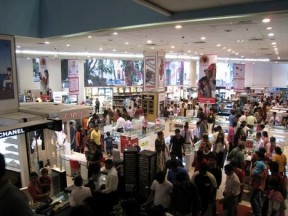Indian retailers suffered the highest loss of stocks to theft in the world for the fifth year in a row in 2011. Half of this loss was attributed to shoplifting by customers. The silver lining here was that India is the world’s only country where the shrink rate (loss of stocks because of thefts by customer, employees and supplier) came down in 2011, according to the Global Retail Theft Barometer 2011.
The shrink rate as a percentage of sales was 2.38 per cent, costing local retailers Rs 3,470 crore, according to the annual survey conducted by the Centre for Retail Research in Nottingham, UK, and underwritten through an independent grant from Checkpoint Systems. The study was conducted across 43 countries between July 2010 and June 2011. In India, it covered 100 retailers, of which 60 were part of modern chains and 40 were from the unorganised sector.
Shoplifting, employee or supplier fraud, organised retail crime and administrative errors cost the retail industry US$119 billion in 2011 or 1.45 per cent of sales. This global shrink rate is 6.6 per cent (0.8 per cent in Asia-Pacific) higher than the previous year. Dishonest employees were responsible for US$41.65 billion or 35 per cent of shrink. In Asia-Pacific, a majority of retailers perceive dishonest customers as the single most important source of loss, responsible for US$9.7 billion of losses or 53.3 per cent. However, the average amount admitted stolen by employees was more than four times the average stolen by shoplifters.
“Shrinkage reported by most retailers is due to multiple causes, not only outright theft. This includes factors such as supply chain and storage losses, quasi-shrinkage due to poor data integrity, and due to causes that lie outside the store rather than in-store,” pointed out Devangshu Dutta, Chief Executive of Third Eyesight, a New Delhi-based consulting firm which focuses on the retail and consumer products ecosystem. Third Eyesight works with retailers (including including e-tailers), brands and manufacturers, as well as service organisations and suppliers to the retail sector and the consumer goods supply chain.
“Although there are commentators who view retail crime as a harmless or intriguing social phenomenon or simply as a cost of doing business, this ignores the impact of criminal gangs, growing levels of violence against employees and customers, and the links between retail crime and drugs, fraud and extortion,” said Professor Joshua Bamfield, Director of the Centre for Retail Research and author of the study. “Moreover, retail crime on average cost families in the 43 countries surveyed an extra US$200 on their shopping bill, up from US$186 last year. In the U.S., that figure was US$115 in Asia-Pacific.”
The 2011 study also found that while retailers increased their spending on loss prevention and security by 5.6 per cent over 2010 to US$28.3 billion globally, loss prevention equipment’s share of total loss prevention expenditures actually declined slightly. This may be why fewer thieves were apprehended globally. The region with the sharpest decline in loss prevention equipment’s share of expenditures was Europe, down 6.25 per cent. Notably, shrink in Europe increased 7.8 per cent, topping the global average.
“Of the top 50 global retailers who responded to the survey, the ones which reported a decline in shrink from the previous year did not construe loss prevention merely as a matter of theft, but worked across their operations to systematically combat shoplifting, employee theft, vendor loss and administrative errors. 96 percent of these retailers’ stores used audit programmes to monitor the use of loss prevention policies and above all, the retailers increased their loss prevention spending almost twice as much as the global average,” said Bamfield.
In Asia-Pacific, shrinkage was highest among categories like cosmetics, perfumes, health and beauty and pharmacy; apparel and accessories; and video, music and gaming. The most-stolen items from the cosmetics category globally included shaving products, perfumes, lipsticks, scissors, nail clippers, tweezers. High quality seafood, alcohol and fresh meat made up the top three most-stolen grocery ‘high-risk’ product lines.
So, where does this place India? Is there more than meets the CCTV eye?
Said Dutta, “The articles that I have read about the study do not provide a comparison of modern retail stores in India and their counterparts in the west. It would be useful to look at a like-for-like comparison, rather than comparing unlike retail formats, or taking an ‘industry’ average, when the research samples in different countries are so varied. Smaller stores lack sophisticated information systems to capture and transmit data as accurately as the large stores, as well as storage and handling processes are also less sophisticated. This increases the shrinkage due to non-theft factors, which would also reflect in the ‘total shrinkage’. Having a higher proportion of traditional retail outlets in a study sample can compound this inaccuracy.”
This article was originally written for the Deadline Delhi column in Asian Correspondent. It has been reproduced here with the author’s permission. Subir Ghosh blogs at www.write2kill.in.






